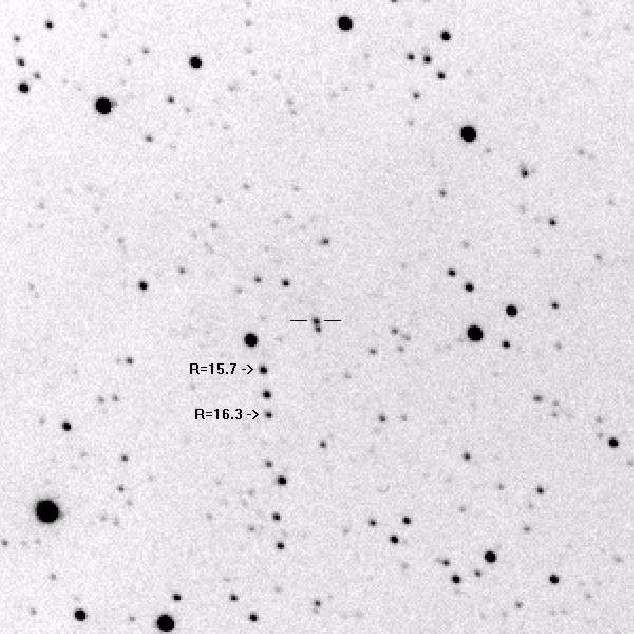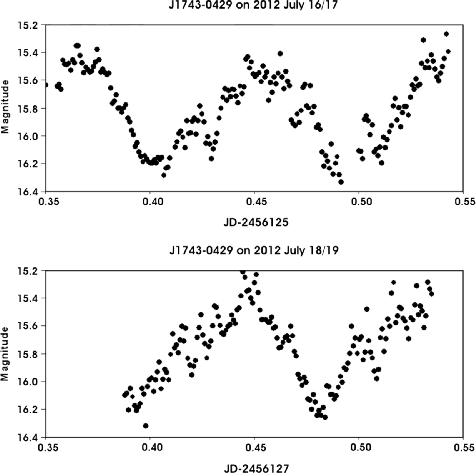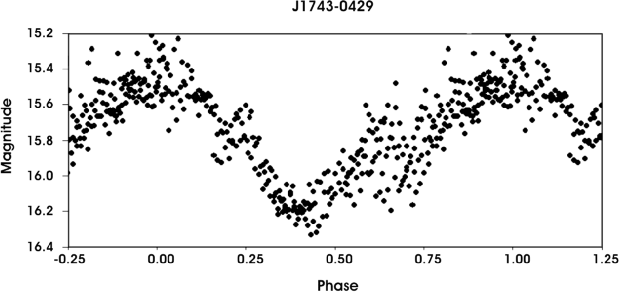|
Peremennye Zvezdy (Variable Stars) 32, No. 3, 2012 Received 26 July; accepted 14 August.
|
Article in PDF |
A Study of the Cataclysmic Variable 1RXS J174320.1-042953
D. V. Denisenko1, F. Martinelli2
- Sternberg Astronomical Institute at Lomonosov Moscow State
University, Russia;
e-mail: d.v.denisenko@gmail.com - Montecatini Astronomical Centre, Italy; e-mail: info@astronomicalcentre.org
|
We report on our photometric analysis of the poorly
studied cataclysmic variable in Ophiuchus, 1RXS J174320.1-042953
(DDE 11). The results of the monitoring with the Bradford Robotic
Telescope (BRT) are presented, as well as the time-resolved
photometry obtained at the Montecatini Astronomical Centre. The
long-term behavior of J1743-0429 shows that it is a probable
magnetic cataclysmic variable (polar), with a large difference
between its low and high states. The orbital period obtained from
our observations is 0 |
The cataclysmic variable DDE 11=1RXS J174320.1-042953
(
![]() ,
,
![]() ,
J2000; UCAC3) was identified by Denisenko and Sokolovsky (2011)
from its magnitudes in the USNO-B1.0 catalogue (
,
J2000; UCAC3) was identified by Denisenko and Sokolovsky (2011)
from its magnitudes in the USNO-B1.0 catalogue (
![]() ,
,
![]() ,
,
![]() ,
,
![]() ). They suggested
the star to be a dwarf nova that had been in outburst on July 1,
1954, when the first-epoch Palomar Observatory Sky Survey blue and
red plates had been obtained.
). They suggested
the star to be a dwarf nova that had been in outburst on July 1,
1954, when the first-epoch Palomar Observatory Sky Survey blue and
red plates had been obtained.
After the discovery of variability on the digitized photographic
plates and in the USNO-B1.0 catalog, one of us (D.D.) started
monitoring the variable with the Bradford Robotic Telescope
located on Tenerife (Canary Islands, Spain). The images from the
0.35-m ![]() telescope with an FLI Microline CCD (1k
telescope with an FLI Microline CCD (1k![]() 1k
pixels) were requested via the website http://www.telescope.org.
Due to the large number of observers using this publicly available
facility, the requests are fulfilled at irregular time intervals.
Typically one has to wait for an image from 2 weeks to 2 months
after submitting the request. However, even this arrangement of
observations allows one to obtain valuable data on the long-term
behavior of cataclysmic variables.
1k
pixels) were requested via the website http://www.telescope.org.
Due to the large number of observers using this publicly available
facility, the requests are fulfilled at irregular time intervals.
Typically one has to wait for an image from 2 weeks to 2 months
after submitting the request. However, even this arrangement of
observations allows one to obtain valuable data on the long-term
behavior of cataclysmic variables.
In the case of 1RXS J174320.1-042953 (hereafter referred to as J1743-0429 for brevity), the BRT observations have shown that the initial hypothesis of this star being a dwarf nova was incorrect. Instead of spending most time at quiescence with occasional outbursts, J1743-0429 was found to be always near the high state. The results of the BRT observations are presented in Table 1.
Observations were performed in the white light with 60-second
exposures. Magnitudes were measured using USNO-A2.0 0825-11051991
(
![]() ,
,
![]() ,
J2000;
,
J2000;
![]() ) as a reference star and USNO-A2.0
0825-11051825 (
) as a reference star and USNO-A2.0
0825-11051825 (
![]() ,
,
![]() , J2000;
, J2000;
![]() ) as a check star.
The variable, reference and check stars are shown in Fig. 1 which
is a sum of two best BRT exposures. It should be noted that the
image scale of the Galaxy camera is
) as a check star.
The variable, reference and check stars are shown in Fig. 1 which
is a sum of two best BRT exposures. It should be noted that the
image scale of the Galaxy camera is ![]() per pixel and that
there is another star only
per pixel and that
there is another star only ![]() to the south of the variable.
This is why the aperture radius, the width of the annulus where
the sky background is measured, and the width of the gap between
this annulus and the aperture were all set to 3 pixels.
to the south of the variable.
This is why the aperture radius, the width of the annulus where
the sky background is measured, and the width of the gap between
this annulus and the aperture were all set to 3 pixels.
 |
Fig. 1.
The finder chart of J1743-0429 from a
Bradford Robotic Telescope image. North is up, east is to the
left. The field of view is |
 |
Fig. 2. Light curves of J1743-0429 obtained at the Montecatini Astronomical Centre on 2012 July 16/17 (top) and 2012 July 18/19 (bottom). |
Following the request by D.D., time-resolved photometry of J1743-0429 was performed by F.M. at the Montecatini Astronomical Centre (http://www.astronomicalcentre.org) on two nights using an 0.35-m telescope equipped with an ST8-XME CCD camera. 70-second unfiltered exposures were taken on both nights. A 4.6-hour-long time series was obtained on 2012 July 16/17 and a 3.5-hour-long one, on July 18/19. The images were calibrated using flat fields and dark frames obtained on the same night. The photometry was made using the same reference and check stars as indicated above.
The light curves for both nights are shown in Fig. 2. The combined
data set was analyzed using the WinEffect software by Dr.
V.P. Goranskij. Period search was performed using the Deeming and
Lafler-Kinman methods. Both algorithms have provided the best
period value of 0![]() 0866(3), or 11.55 cycles per day. The
periodogram in the 8-16 cycles/day range obtained for the
Lafler-Kinman method is shown in Fig. 3 and the resulting phased
light curve, in Fig. 4.
0866(3), or 11.55 cycles per day. The
periodogram in the 8-16 cycles/day range obtained for the
Lafler-Kinman method is shown in Fig. 3 and the resulting phased
light curve, in Fig. 4.
The main features of the light curve are its quite large amplitude
(0![]() 8) and a dip by about 0
8) and a dip by about 0![]() 4 shortly before the maximum.
Together with the orbital period close to the bottom edge of the
cataclysmic-variable period gap, these features are indicating the
probable polar nature of this cataclysmic variable.
4 shortly before the maximum.
Together with the orbital period close to the bottom edge of the
cataclysmic-variable period gap, these features are indicating the
probable polar nature of this cataclysmic variable.
One can also suspect a hint to shorter-period brightness
variations superimposed on the main orbital curve. It is possible
that this cataclysmic variable is an intermediate polar with a
quickly rotating white dwarf. Photometric time series with a
larger-aperture telescope are required to study this variable in
more detail. We also encourage spectroscopic studies, to measure
relative intensities of the HeII 4686 Å and H![]() lines.
lines.
References:
Denisenko D.V., Sokolovsky K.V., 2011, Astron. Letters, 37, 91

